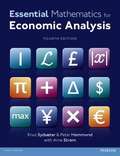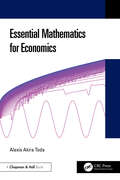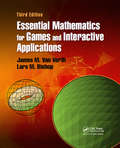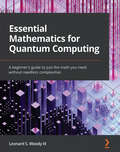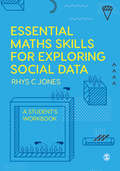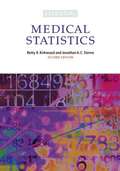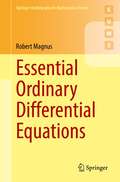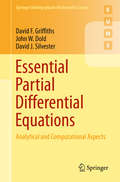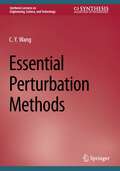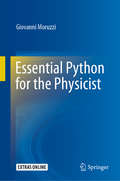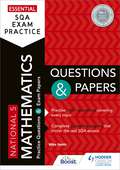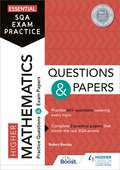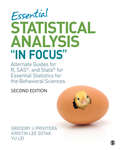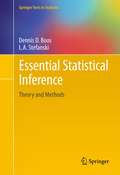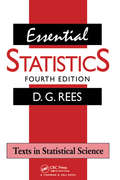- Table View
- List View
Essential Mathematical Methods for the Physical Sciences
by M. P. Hobson K. F. Riley"The mathematical methods that physical scientists need for solving substantial problems in their fields of study are set out clearly and simply in this tutorial-style textbook. Students will develop problem-solving skills through hundreds of worked examples, self-test questions and homework problems. Each chapter concludes with a summary of the main procedures and results and all assumed prior knowledge is summarized in one of the appendices. Over 300 worked examples show how to use the techniques and around 100 self-test questions in the footnotes act as checkpoints to build student confidence. Nearly 400 end-of-chapter problems combine ideas from the chapter to reinforce the concepts. Hints and outline answers to the odd-numbered problems are given at the end of each chapter, with fully-worked solutions to these problems given in the accompanying Student Solutions Manual. Fully-worked solutions to all problems, password-protected for instructors, are available at www. cambridge. org/essential"--
Essential Mathematics for Economic Analysis (Fourth Edition)
by Peter Hammond Knut Sydsaeter Arne StromThis text provides an invaluable introduction to the mathematical tools that undergraduate economists need. The coverage is comprehensive, ranging from elementary algebra to more advanced material, whilst focusing on all the core topics that are usually taught in undergraduate courses on mathematics for economists.
Essential Mathematics for Economics
by Alexis Akira TodaEssential Mathematics for Economics covers mathematical topics that are essential for economic analysis in a concise but rigorous fashion. The book covers selected topics such as linear algebra, real analysis, convex analysis, constrained optimization, dynamic programming, and numerical analysis in a single volume. The book is entirely self-contained, and almost all propositions are proved. Features Replete with exercises and illuminating examples Suitable as a primary text for an advanced undergraduate or postgraduate course on mathematics for economics Basic linear algebra and real analysis are the only prerequisites. Supplementary materials such as Matlab codes, teaching slides etc. are posted on the book website https://github.com/alexisakira/EME.
Essential Mathematics for Games and Interactive Applications
by James M. Van Verth Lars M. BishopExpert Guidance on the Math Needed for 3D Game ProgrammingDeveloped from the authors' popular Game Developers Conference (GDC) tutorial, Essential Mathematics for Games and Interactive Applications, Third Edition illustrates the importance of mathematics in 3D programming. It shows you how to properly animate, simulate, and render scenes and discus
Essential Mathematics for Political and Social Research
by Jeff GillEssential Mathematics for Political and Social Research addresses an educational deficiency in the social and behavioral sciences. This 2006 book was the first of its kind to specifically address the comprehensive introduction to the mathematical principles needed by modern social scientists. The material introduces basic mathematical principles necessary to do analytical work in the social sciences, starting from first principles, but without unnecessary complexity. The core purpose is to present fundamental notions in standard notation and standard language with a clear, unified framework throughout. Through examples and exercises, this book is intended to not only motivate specific mathematical principles and practices, but also introduce the way that social science researchers use these tools. The intended emphasis is on conceptual understanding of key principles and their subsequent application.
Essential Mathematics for Quantum Computing: A beginner's guide to just the math you need without needless complexities
by Leonard S. Woody IIIDemystify quantum computing by learning the math it is built onKey FeaturesBuild a solid mathematical foundation to get started with developing powerful quantum solutionsUnderstand linear algebra, calculus, matrices, complex numbers, vector spaces, and other concepts essential for quantum computingLearn the math needed to understand how quantum algorithms functionBook DescriptionQuantum computing is an exciting subject that offers hope to solve the world's most complex problems at a quicker pace. It is being used quite widely in different spheres of technology, including cybersecurity, finance, and many more, but its concepts, such as superposition, are often misunderstood because engineers may not know the math to understand them. This book will teach the requisite math concepts in an intuitive way and connect them to principles in quantum computing.Starting with the most basic of concepts, 2D vectors that are just line segments in space, you'll move on to tackle matrix multiplication using an instinctive method. Linearity is the major theme throughout the book and since quantum mechanics is a linear theory, you'll see how they go hand in hand. As you advance, you'll understand intrinsically what a vector is and how to transform vectors with matrices and operators. You'll also see how complex numbers make their voices heard and understand the probability behind it all.It's all here, in writing you can understand. This is not a stuffy math book with definitions, axioms, theorems, and so on. This book meets you where you're at and guides you to where you need to be for quantum computing. Already know some of this stuff? No problem! The book is componentized, so you can learn just the parts you want. And with tons of exercises and their answers, you'll get all the practice you need.What you will learnOperate on vectors (qubits) with matrices (gates)Define linear combinations and linear independenceUnderstand vector spaces and their basis setsRotate, reflect, and project vectors with matricesRealize the connection between complex numbers and the Bloch sphereDetermine whether a matrix is invertible and find its eigenvaluesProbabilistically determine the measurement of a qubitTie it all together with bra-ket notationWho this book is forIf you want to learn quantum computing but are unsure of the math involved, this book is for you. If you've taken high school math, you'll easily understand the topics covered. And even if you haven't, the book will give you a refresher on topics such as trigonometry, matrices, and vectors. This book will help you gain the confidence to fully understand quantum computation without losing you in the process!
Essential Maths Skills for AS/A Level Design and Technology
by Chris Walker Peter WarneDon't let your students miss out on easy marks, prepare them for those Maths questions with this essential guide.Written specifically to build students' confidence in maths and to prepare them for the more challenging mathematical requirements which make up 15% of the new DT specifications.- Improve confidence with structured progression of worked examples, guided and non-guided questions, and worked solutions for every question- Strengthen students' maths skills and subject understanding with worked examples andpractice questions all embedded in the subject context- Develop exam confidence with exam-style maths questions- An essential tool throughout the AS and A Level course with every maths skill mapped tosubject topics, and applicable to every major exam board- Reviewed by subject and maths expert Glyn Granger (former D&T chief examiner)
Essential Maths Skills for AS/A Level Design and Technology (Essential Maths Skills)
by Chris Walker Peter WarneDon't let your students miss out on easy marks, prepare them for those Maths questions with this essential guide.Written specifically to build students' confidence in maths and to prepare them for the more challenging mathematical requirements which make up 15% of the new DT specifications.- Improve confidence with structured progression of worked examples, guided and non-guided questions, and worked solutions for every question- Strengthen students' maths skills and subject understanding with worked examples andpractice questions all embedded in the subject context- Develop exam confidence with exam-style maths questions- An essential tool throughout the AS and A Level course with every maths skill mapped tosubject topics, and applicable to every major exam board- Reviewed by subject and maths expert Glyn Granger (former D&T chief examiner)
Essential Maths Skills for Exploring Social Data: A Student′s Workbook
by Rhys Christopher JonesAre you feeling anxious about statistics? This hands-on workbook is packed with clear explanations, real-world examples and practical exercises to give you the maths skills you need to tackle statistics with confidence. Grounded in a social science context, it features: · Clear introductions to symbols and tasks · Multiple choice questions and exercises · Real world case studies and datasets · A glossary of terms To help you practice, this book is accompanied by useful online resources, including datasets and questions, as well as a selection of author videos.
Essential Maths Skills for Exploring Social Data: A Student′s Workbook
by Rhys Christopher JonesAre you feeling anxious about statistics? This hands-on workbook is packed with clear explanations, real-world examples and practical exercises to give you the maths skills you need to tackle statistics with confidence. Grounded in a social science context, it features: · Clear introductions to symbols and tasks · Multiple choice questions and exercises · Real world case studies and datasets · A glossary of terms To help you practice, this book is accompanied by useful online resources, including datasets and questions, as well as a selection of author videos.
Essential Medical Statistics
by Betty R. Kirkwood Jonathan A. C. SterneBlackwell Publishing is delighted to announce that this book has been Highly Commended in the 2004 BMA Medical Book Competition. Here is the judges' summary of this book: "This is a technical book on a technical subject but presented in a delightful way. There are many books on statistics for doctors but there are few that are excellent and this is certainly one of them. Statistics is not an easy subject to teach or write about. The authors have succeeded in producing a book that is as good as it can get. For the keen student who does not want a book for mathematicians, this is an excellent first book on medical statistics." Essential Medical Statistics is a classic amongst medical statisticians. An introductory textbook, it presents statistics with a clarity and logic that demystifies the subject, while providing a comprehensive coverage of advanced as well as basic methods. The second edition of Essential Medical Statistics has been comprehensively revised and updated to include modern statistical methods and modern approaches to statistical analysis, while retaining the approachable and non-mathematical style of the first edition. The book now includes full coverage of the most commonly used regression models, multiple linear regression, logistic regression, Poisson regression and Cox regression, as well as a chapter on general issues in regression modelling. In addition, new chapters introduce more advanced topics such as meta-analysis, likelihood, bootstrapping and robust standard errors, and analysis of clustered data. Aimed at students of medical statistics, medical researchers, public health practitioners and practising clinicians using statistics in their daily work, the book is designed as both a teaching and a reference text. The format of the book is clear with highlighted formulae and worked examples, so that all concepts are presented in a simple, practical and easy-to-understand way. The second edition enhances the emphasis on choice of appropriate methods with new chapters on strategies for analysis and measures of association and impact. Essential Medical Statistics is supported by a web site at www.blackwellpublishing.com/essentialmedstats. This useful online resource provides statistical datasets to download, as well as sample chapters and future updates.
Essential Microeconomics
by John G. RileyEssential Microeconomics is designed to help students deepen their understanding of the core theory of microeconomics. Unlike other texts, this book focuses on the most important ideas and does not attempt to be encyclopedic. Two-thirds of the textbook focuses on price theory. As well as taking a new look at standard equilibrium theory, there is extensive examination of equilibrium under uncertainty, the capital asset pricing model, and arbitrage pricing theory. Choice over time is given extensive coverage and includes a basic introduction to control theory. The final third of the book, on game theory, provides a comprehensive introduction to models with asymmetric information. Topics such as auctions, signaling, and mechanism design are made accessible to students who have a basic rather than a deep understanding of mathematics. There is ample use of examples and diagrams to illustrate issues as well as formal derivations. Essential Microeconomics is designed to help students deepen their understanding of the core theory of microeconomics.
Essential Ordinary Differential Equations (Springer Undergraduate Mathematics Series)
by Robert MagnusThis textbook offers an engaging account of the theory of ordinary differential equations intended for advanced undergraduate students of mathematics. Informed by the author’s extensive teaching experience, the book presents a series of carefully selected topics that, taken together, cover an essential body of knowledge in the field. Each topic is treated rigorously and in depth.The book begins with a thorough treatment of linear differential equations, including general boundary conditions and Green’s functions. The next chapters cover separable equations and other problems solvable by quadratures, series solutions of linear equations and matrix exponentials, culminating in Sturm–Liouville theory, an indispensable tool for partial differential equations and mathematical physics. The theoretical underpinnings of the material, namely, the existence and uniqueness of solutions and dependence on initial values, are treated at length. A noteworthy feature of this book is the inclusion of project sections, which go beyond the main text by introducing important further topics, guiding the student by alternating exercises and explanations. Designed to serve as the basis for a course for upper undergraduate students, the prerequisites for this book are a rigorous grounding in analysis (real and complex), multivariate calculus and linear algebra. Some familiarity with metric spaces is also helpful. The numerous exercises of the text provide ample opportunities for practice, and the aforementioned projects can be used for guided study. Some exercises have hints to help make the book suitable for independent study.fsfsfsscs
Essential Partial Differential Equations
by David F. Griffiths John W. Dold David J. SilvesterThis volume provides an introduction to the analytical and numerical aspects of partial differential equations (PDEs). It unifies an analytical and computational approach for these; the qualitative behaviour of solutions being established using classical concepts: maximum principles and energy methods. Notable inclusions are the treatment of irregularly shaped boundaries, polar coordinates and the use of flux-limiters when approximating hyperbolic conservation laws. The numerical analysis of difference schemes is rigorously developed using discrete maximum principles and discrete Fourier analysis. A novel feature is the inclusion of a chapter containing projects, intended for either individual or group study, that cover a range of topics such as parabolic smoothing, travelling waves, isospectral matrices, and the approximation of multidimensional advection-diffusion problems. The underlying theory is illustrated by numerous examples and there are around 300 exercises, designed to promote and test understanding. They are starred according to level of difficulty. Solutions to odd-numbered exercises are available to all readers while even-numbered solutions are available to authorised instructors. Written in an informal yet rigorous style, Essential Partial Differential Equations is designed for mathematics undergraduates in their final or penultimate year of university study, but will be equally useful for students following other scientific and engi neering disciplines in which PDEs are of practical importance. The only prerequisite is a familiarity with the basic concepts of calculus and linear algebra.
Essential Perturbation Methods (Synthesis Lectures on Engineering, Science, and Technology)
by C.Y. WangThis book presents the modeling and scaling of physical problems, which result in normalized perturbation equations. This is followed by solving perturbation problems and evaluating the results. The author refines perturbation methods into simple, understandable elements and avoids unnecessary theorems and proofs. In addition, the results are consolidated and interpreted, and the presented examples are succinct to illustrate the essential techniques. This book is ideal and beneficial for practicing scientists and engineers who need to understand and apply perturbation methods to difficult problems with applications in mathematics, engineering, and biology. Discussions on new perspectives, simpler presentations on convergence, and the expansion of integrals are included.
Essential Python for the Physicist
by Giovanni MoruzziThis book introduces the reader with little or no previous computer-programming experience to the Python programming language of interest for a physicist or a natural-sciences student. The book starts with basic interactive Python in order to acquire an introductory familiarity with the language, than tackle Python scripts (programs) of increasing complexity, that the reader is invited to run on her/his computer. All program listings are discussed in detail, and the reader is invited to experiment on what happens if some code lines are modified. The reader is introduced to Matplotlib graphics for the generation of figures representing data and function plots and, for instance, field lines. Animated function plots are also considered. A chapter is dedicated to the numerical solution of algebraic and transcendental equations, the basic mathematical principles are discussed and the available Python tools for the solution are presented. A further chapter is dedicated to the numerical solution of ordinary differential equations. This is of vital importance for the physicist, since differential equations are at the base of both classical physics (Newton’s equations) and quantum mechanics (Schroedinger’s equation). The shooting method for the numerical solution of ordinary differential equations with boundary conditions at two boundaries is also presented. Python programs for the solution of two quantum-mechanics problems are discussed as examples. Two chapters are dedicated to Tkinter graphics, which gives the user more freedom than Matplotlib, and to Tkinter animation. Programs displaying the animation of physical problems involving the solution of ordinary differential equations (for which in most cases there is no algebraic solution) in real time are presented and discussed. Finally, 3D animation is presented with Vpython.
Essential SQA Exam Practice: From the publisher of How to Pass
by Mike SmithExam board: SQALevel: National 5Subject: MathematicsFirst teaching: September 2017First exam: Summer 2018Practice makes permanent. Feel confident and prepared for the SQA National 5 Maths exam with this two-in-one book, containing practice questions for every topic, plus two full practice papers - all written by an experienced examiner.- Choose which topics you want to revise: A simple grid enables you to pick particular areas of the course that you want to answer questions on, with solutions provided at the back of the book- Remember more in your exam: Repeated and extended practice of calculator and non-calculator questions will improve your numerical, algebraic, geometric, trigonometric, statistical and reasoning skills- Familiarise yourself with the exam papers: Both practice papers mirror the language and layout of the real SQA papers; complete them in timed, exam-style conditions to increase your confidence before the exams- Find out how to achieve a better grade: Answers to the practice papers have commentaries for each question, with tips on writing successful answers and avoiding common mistakesFully up to date with SQA's requirementsThe questions, mark schemes and guidance in this practice book match the requirements of the revised SQA National 5 Maths specification for examination from 2018 onwards.
Essential SQA Exam Practice: From the publisher of How to Pass
by Mike SmithExam board: SQALevel: National 5Subject: MathematicsFirst teaching: September 2017First exam: Summer 2018Practice makes permanent. Feel confident and prepared for the SQA National 5 Maths exam with this two-in-one book, containing practice questions for every topic, plus two full practice papers - all written by an experienced examiner.- Choose which topics you want to revise: A simple grid enables you to pick particular areas of the course that you want to answer questions on, with solutions provided at the back of the book- Remember more in your exam: Repeated and extended practice of calculator and non-calculator questions will improve your numerical, algebraic, geometric, trigonometric, statistical and reasoning skills- Familiarise yourself with the exam papers: Both practice papers mirror the language and layout of the real SQA papers; complete them in timed, exam-style conditions to increase your confidence before the exams- Find out how to achieve a better grade: Answers to the practice papers have commentaries for each question, with tips on writing successful answers and avoiding common mistakesFully up to date with SQA's requirementsThe questions, mark schemes and guidance in this practice book match the requirements of the revised SQA National 5 Maths specification for examination from 2018 onwards.
Essential SQA Exam Practice: From the publisher of How to Pass
by Robert BarclayExam board: SQALevel: HigherSubject: MathematicsFirst teaching: September 2018First exam: Summer 2019Practice makes permanent. Feel confident and prepared for the SQA Higher Maths exam with this two-in-one book, containing practice questions for every topic, plus two full practice papers - all written by an experienced examiner.- Choose which topics you want to revise: A simple grid enables you to pick particular areas of the course that you want to answer questions on, with solutions provided at the back of the book- Remember more in your exam: Repeated and extended practice of calculator and non-calculator questions will improve your algebraic, trigonometric, geometric, calculus and reasoning skills- Familiarise yourself with the exam papers: Both practice papers mirror the language and layout of the real SQA papers; complete them in timed, exam-style conditions to increase your confidence before the exams- Find out how to achieve a better grade: Answers to the practice papers have commentaries for each question, with tips on writing successful answers and avoiding common mistakesFully up to date with SQA's requirementsThe questions, mark schemes and guidance in this practice book match the requirements of the revised SQA Higher Maths specification for examination from 2019 onwards.
Essential SQA Exam Practice: From the publisher of How to Pass
by Robert BarclayExam board: SQALevel: HigherSubject: MathematicsFirst teaching: September 2018First exam: Summer 2019Practice makes permanent. Feel confident and prepared for the SQA Higher Maths exam with this two-in-one book, containing practice questions for every topic, plus two full practice papers - all written by an experienced examiner.- Choose which topics you want to revise: A simple grid enables you to pick particular areas of the course that you want to answer questions on, with solutions provided at the back of the book- Remember more in your exam: Repeated and extended practice of calculator and non-calculator questions will improve your algebraic, trigonometric, geometric, calculus and reasoning skills- Familiarise yourself with the exam papers: Both practice papers mirror the language and layout of the real SQA papers; complete them in timed, exam-style conditions to increase your confidence before the exams- Find out how to achieve a better grade: Answers to the practice papers have commentaries for each question, with tips on writing successful answers and avoiding common mistakesFully up to date with SQA's requirementsThe questions, mark schemes and guidance in this practice book match the requirements of the revised SQA Higher Maths specification for examination from 2019 onwards.
Essential Statistical Analysis "In Focus": Alternate Guides for R, SAS, and Stata for Essential Statistics for the Behavioral Sciences
by Yu Lei Kristin L. Sotak Gregory J. PriviteraEssentials of Statistical Analysis "In Focus" supports users of Gregory J. Privitera’s Essential Statistics for the Behavioral Sciences, Second Edition who work with a statistical program other than SPSS® or Excel®. Three standalone parts, each dedicated to R, SAS®, and Stata®, serve as step-by-step guides for completing the "In Focus" exercises in Privitera’s core text. A conversational writing style along with "To The Student" introductions allow students to familiarize themselves and become more comfortable with each program prior to making computations. Additionally, General Instruction Guidebook (GIG) sections for R, SAS®, and Stata® provide standardized how-to instructions for using each program, making the book a valuable reference for students beyond their studies.
Essential Statistical Analysis "In Focus": Alternate Guides for R, SAS, and Stata for Essential Statistics for the Behavioral Sciences
by Yu Lei Kristin L. Sotak Gregory J. PriviteraEssentials of Statistical Analysis "In Focus" supports users of Gregory J. Privitera’s Essential Statistics for the Behavioral Sciences, Second Edition who work with a statistical program other than SPSS® or Excel®. Three standalone parts, each dedicated to R, SAS®, and Stata®, serve as step-by-step guides for completing the "In Focus" exercises in Privitera’s core text. A conversational writing style along with "To The Student" introductions allow students to familiarize themselves and become more comfortable with each program prior to making computations. Additionally, General Instruction Guidebook (GIG) sections for R, SAS®, and Stata® provide standardized how-to instructions for using each program, making the book a valuable reference for students beyond their studies.
Essential Statistical Inference
by Dennis D. Boos L A StefanskiThis book is for students and researchers who have had a first year graduate level mathematical statistics course. It covers classical likelihood, Bayesian, and permutation inference; an introduction to basic asymptotic distribution theory; and modern topics like M-estimation, the jackknife, and the bootstrap. R code is woven throughout the text, and there are a large number of examples and problems. An important goal has been to make the topics accessible to a wide audience, with little overt reliance on measure theory. A typical semester course consists of Chapters 1-6 (likelihood-based estimation and testing, Bayesian inference, basic asymptotic results) plus selections from M-estimation and related testing and resampling methodology. Dennis Boos and Len Stefanski are professors in the Department of Statistics at North Carolina State. Their research has been eclectic, often with a robustness angle, although Stefanski is also known for research concentrated on measurement error, including a co-authored book on non-linear measurement error models. In recent years the authors have jointly worked on variable selection methods.
Essential Statistical Physics
by Malcolm P. KennettThis clear and pedagogical text delivers a concise overview of classical and quantum statistical physics. Essential Statistical Physics shows students how to relate the macroscopic properties of physical systems to their microscopic degrees of freedom, preparing them for graduate courses in areas such as biophysics, condensed matter physics, atomic physics and statistical mechanics. Topics covered include the microcanonical, canonical, and grand canonical ensembles, Liouville's Theorem, Kinetic Theory, non-interacting Fermi and Bose systems and phase transitions, and the Ising model. Detailed steps are given in mathematical derivations, allowing students to quickly develop a deep understanding of statistical techniques. End-of-chapter problems reinforce key concepts and introduce more advanced applications, and appendices provide a detailed review of thermodynamics and related mathematical results. This succinct book offers a fresh and intuitive approach to one of the most challenging topics in the core physics curriculum and provides students with a solid foundation for tackling advanced topics in statistical mechanics.
Essential Statistics
by D.G. ReesAn introductory text for students taking a first course in statistics-in fields as diverse as engineering, business, chemistry, and biology-Essential Statistics: Fourth Edition thoroughly updates and enhances the hugely successful third edition. It presents new information on modern statistical techniques such as Analysis of Variance (ANOVA), and software such as MINITAB™ for WINDOWS.An experienced former lecturer, the author communicates to students in his trademark easy-to-follow style. Keeping complex mathematical theory to a minimum, Rees presents a wealth of fully explained worked examples throughout the text. In addition, the end-of-chapter Worksheets relate to a variety of fields-enabling students to see the relevance of the numerous methods to their study areas. Essential Statistics: Fourth Edition emphasizes the principles and assumptions underlying the statistical methods, thus providing the tools needed for students to use and interpret statistical data effectively.

